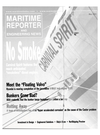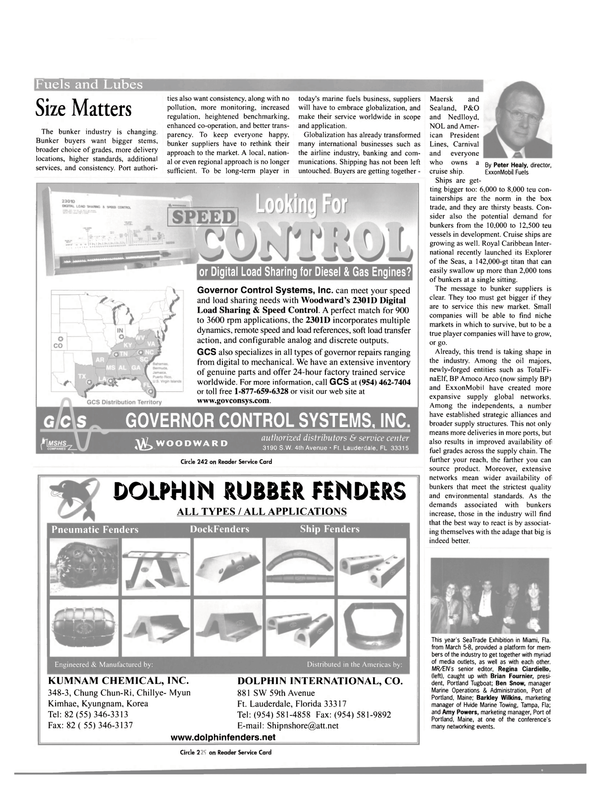
Size Matters
The bunker industry is changing.
Bunker buyers want bigger stems, broader choice of grades, more delivery locations, higher standards, additional services, and consistency. Port authorities also want consistency, along with no pollution, more monitoring, increased regulation, heightened benchmarking, enhanced co-operation, and better transparency.
To keep everyone happy, bunker suppliers have to rethink their approach to the market. A local, national or even regional approach is no longer sufficient. To be long-term player in today's marine fuels business, suppliers will have to embrace globalization, and make their service worldwide in scope and application.
Globalization has already transformed many international businesses such as the airline industry, banking and communications.
Shipping has not been left untouched. Buyers are getting together - Maersk and Sealand, P&O and Nedlloyd, NOL and American President Lines, Carnival and everyone who owns a cruise ship.
Ships are getting bigger too: 6,000 to 8,000 teu containerships are the norm in the box trade, and they are thirsty beasts. Consider also the potential demand for bunkers from the 10,000 to 12,500 teu vessels in development. Cruise ships are growing as well. Royal Caribbean International recently launched its Explorer of the Seas, a 142,000-gt titan that can easily swallow up more than 2,000 tons of bunkers at a single sitting.
The message to bunker suppliers is clear. They too must get bigger if they are to service this new market. Small companies will be able to find niche markets in which to survive, but to be a true player companies will have to grow, or go.
Already, this trend is taking shape in the industry. Among the oil majors, newly-forged entities such as TotalFinaElf, BP Amoco Arco (now simply BP) and ExxonMobil have created more expansive supply global networks.
Among the independents, a number have established strategic alliances and broader supply structures. This not only means more deliveries in more ports, but also results in improved availability of fuel grades across the supply chain. The further your reach, the farther you can source product. Moreover, extensive networks mean wider availability of bunkers that meet the strictest quality and environmental standards. As the demands associated with bunkers increase, those in the industry will find that the best way to react is by associating themselves with the adage that big is indeed better.
Read Size Matters in Pdf, Flash or Html5 edition of May 2001 Maritime Reporter
Other stories from May 2001 issue
Content
- EU Subsidy Program To Be Considered page: 4
- Nichols Brothers Delivers 39-knot Catamaran page: 4
- New Dimension for Hapag-Lloyd page: 8
- Cathedral Power page: 8
- "The Floating Volvo" HHI Builds Twin Engine V-Max VLCC page: 12
- EAR Takes Lead In RoPax Market page: 14
- N e w ATB Joint Venture Is Formed page: 16
- Unauthorized W e l d i n g Caused Carnival Ecstasy Fire page: 17
- Castor's Downfall: Hyper-Accelerated Corrosion page: 18
- N N S 1Q EPS Up 19% page: 27
- N a v y Honors Propeller Expert page: 28
- L-3 Communications Delivers Premiere Production HVR page: 29
- New "Ax-Bow" To Increase Ships' Efficiency page: 30
- R o - C l e a n D e s m i Sets W o r ld R e c o r d For L a r g e s t O il C o n t a i n m e n t B o om page: 31
- Reintjes IPP System Rewarded W i t h Orders page: 32
- Online Design, Drafting Offered page: 32
- Large Passenger Vessels Benefit From Norsafe's Rescube page: 33
- Ensolve Develops Innovative Oily Water Separator page: 34
- Titan Innovation Replaces Sheerleg Crane page: 35
- NavCad V 4 . 0 Released page: 35
- The Tribon Ml Developer's Toolkit page: 36
- Autoship Systems Software: Ruling The Waves page: 36
- Yachting Consult Offers MasterShip page: 37
- Barging Ahead page: 38
- Size Matters page: 42
- ISU Survey Points Out Bunker Concerns page: 43
- Carnivals New Spirit page: 44
- Meet Me In Oslo page: 48
- Norway's Caretaker Protects Precious Cargo page: 50
- 2 0 0 0 A Good Year for MaK page: 57
- AMCV Christens Premiere Vessel In Delta Queen Fleet page: 60


